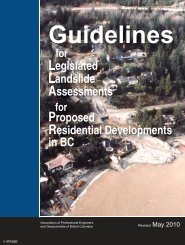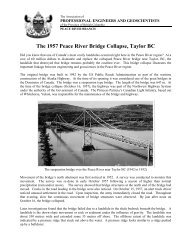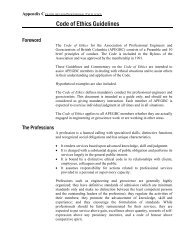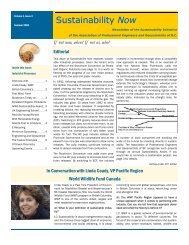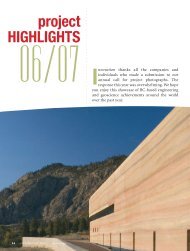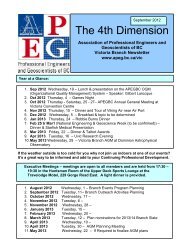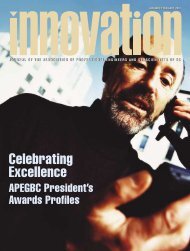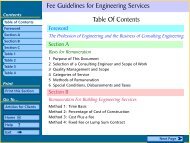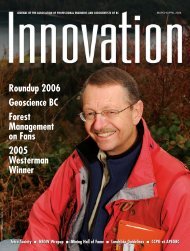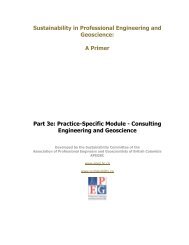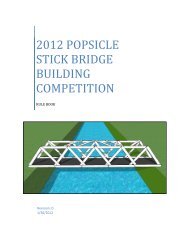3938 APEG Mar.Apr Edit.indd - APEGBC
3938 APEG Mar.Apr Edit.indd - APEGBC
3938 APEG Mar.Apr Edit.indd - APEGBC
Create successful ePaper yourself
Turn your PDF publications into a flip-book with our unique Google optimized e-Paper software.
f eatures<br />
28 MARCH/APRIL 2008 INNOVATION<br />
comparison, have been put into regular service by<br />
TransLink. Westport Innovations has calibrated the buses’<br />
8.3 L C Gas Plus CNG engines so that they burn a gas<br />
mixture containing 20% hydrogen and 80% natural gas<br />
by volume. Th e HCNG and CNG baseline buses are being<br />
subjected to a number of tests and evaluations and are part<br />
of TransLink’s program to evaluate the latest propulsion<br />
technologies and alternative fuels. In the program,<br />
TransLink is monitoring fuel consumption, service calls,<br />
emissions, acceleration, braking, hill climbing ability<br />
and noise. Th ese HCNG buses produce 50% less nitrogen<br />
oxides and 7% less carbon dioxide than CNG buses.<br />
HCNG Transit Bus Fuelling Station<br />
To provide fuel blending and dispensing<br />
services to TransLink for the hydrogen<br />
and compressed natural gas (HCNG)<br />
buses, Clean Energy Fuels upgraded<br />
the existing compressed natural gas<br />
(CNG) fuelling station at TransLink’s<br />
Port Coquitlam bus depot. Th e fuelling<br />
station receives hydrogen from IWHUP’s<br />
compressed hydrogen distribution<br />
project, and mixes it with compressed<br />
natural gas as it is being dispensed to<br />
the buses. Th e mixture contains 20%<br />
hydrogen and 80% natural gas by volume<br />
and is dispensed at pressures up to 300<br />
bar. Th e facility is capable of fi lling the<br />
buses at CNG fast fi ll rates.<br />
Stationary Fuel Cell Demonstration<br />
Demonstrated through application at<br />
a car wash in North Vancouver, a 150<br />
kW Proton Exchange Membrane (PEM)<br />
fuel cell made by Nuvera was integrated<br />
by Sacré Davey to provide power to<br />
Easywash’s cleaning bays, thus lowering<br />
Easywash’s dependence on the BC<br />
electricity grid. Heat, which is naturally<br />
generated by the fuel cell, is used to warm<br />
the process water, increasing the overall<br />
efficiency of the system and further<br />
lowering Easywash’s electricity usage.<br />
Excess electricity is being net metered<br />
back onto the grid.<br />
Challenges<br />
Achieving the goals of the Integrated<br />
Waste Hydrogen Utilization Project within<br />
a short timeframe has not been without<br />
challenges. Numerous technical, logistical<br />
and approval challenges were successfully<br />
overcome by the various consortium<br />
partners before the project entered the<br />
demonstration phase in late 2007. One of<br />
the main challenges faced was the fact that<br />
the codes and standards for this industry<br />
were and are still being developed. Draft<br />
standards for hydrogen installations as well<br />
as other standards from related industries<br />
were studied and cross-referenced. Th e<br />
findings were compiled and used to<br />
develop the design standards.<br />
Perhaps the most challenging problem<br />
encountered was the fuel cell installation



